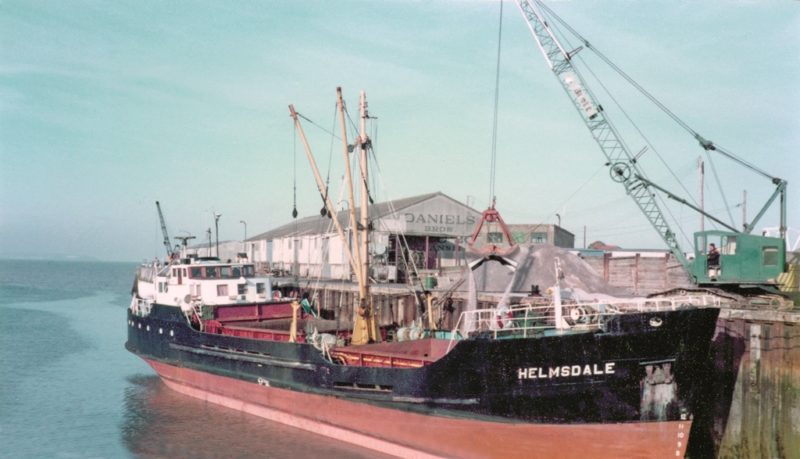
As ‘Staycationers’ last year, my family opted to rent a 200 year old fisherman’s cottage in the North of Scotland’s Black Isle harbour-village of Avoch.
Adjacent to the harbour hard standing was to be found a small ‘U’ shaped plinth, which provided an illustrated but brief history of the port. This included a pair of unclear photographs of small coastal vessels and which sparked my curiosity.
The first, a two masted tops’l schooner, was captioned “Dispatch” and which for many years had traded between Avoch and Aberdeen with inbound cargoes of mainly coal and according to season, outbound with grain, potatoes and/or timber. My subsequent home research revealed the vessel to be the 1888 Garmouth built wooden hulled Inverness registered but Gloucester owned “Despatch”- during the early 1930s reportedly one of the very last Moray Firth designed sailing vessels remaining afloat. Records also indicate that during her later years, the vessel traded from Gloucester to Ireland.
Of greater intrigue however was the adjoining photograph, captioned “The last coal cargo arrived at the harbour in 1984” illustrating the stern aspect of an all-aft, un-named vessel whose design was in the nature of a Dutch motor coaster typical of the 1940s-1950s era. So unclear and somewhat weathered was this mono chrome illustration, that I opted to sketch the vessel’s key features as a means to later identify this seemingly obscure but somewhat attractive little ship. A later search of reference material produced conclusive evidence that the vessel was the 1956 German built 402 gross ton motor coaster Helmsdale. Curious as to her origins with such name, investigation led to the early 19th Century founded village of Helmsdale, now a tourist and river fishing destination, located where the River Ullie (or River Helmsdale as it is more usually referred today) meets the sea on Sutherland’s lower east coast. It was at this port which during earlier years had boasted the largest herring fishing fleet on Scotland’s east coast, thereby providing full local employment and a burgeoning economy, where Helmsdale based George Couper & Co. Ltd., hitherto early 1900s periodic owners of several Wick registered cargo steamers and fishing vessels, operated their main business interests including herring curing and local distribution of coal imports for the region’s residents and fishing fleets.
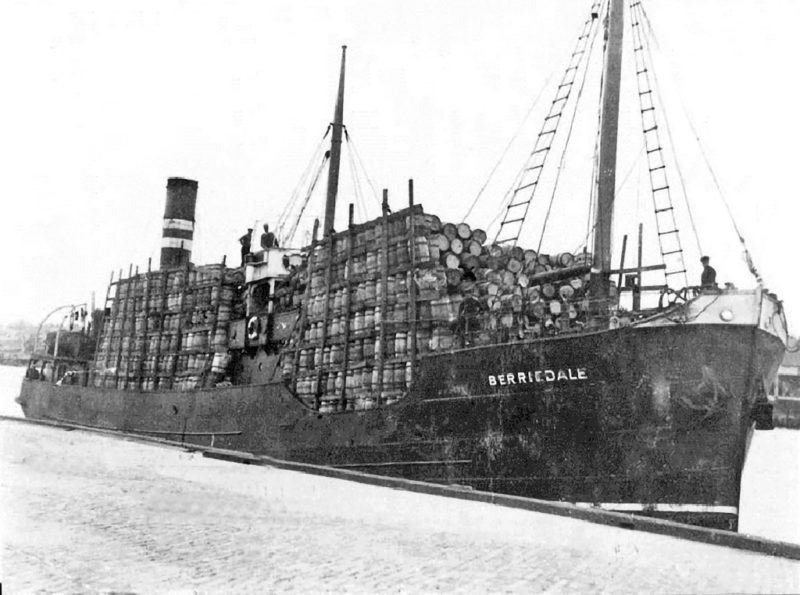
George Couper & Co. Ltd., is recorded as having transferred its interests in fishing vessel ownership to Adam M. Couper circa 1904 and further reference to them therefore, is beyond the bounds of this article.
Whilst earliest 20th Century shipping records for the Company are particularly sparse and fragmented, they suggest that their first ship was the 398 grt 1883 Paisley built iron steamer Sylfaen, acquired during 1900 from the Sylfaen Steam Shipping Co. Ltd. (Kneeshaw, Lupton & Co., Liverpool, Managers). Retained without name change for barely five years, the vessel was sold for further trading to Mann, MacNeal & Co. of Glasgow when renamed Earlford.
A second ship, the 329 grt Shilbottle, completed by Alexander Hall at Aberdeen during April 1910 was purchased during December 1911 from the Shilbottle Steam Shipping Co. Ltd. (W.M. Brechin, Manager at Aberdeen) and re-registered without name change. This acquisition gives all the appearance of an opportunity for financial gain only, for within a matter of weeks, the vessel was given the seemingly unregistered name of St. Donan and whilst at commencement of a passage from Coleraine for Liverpool on 24th February 1912 with a cargo of potatoes and turnips, the vessel on encountering a heavy swell at the notoriously dangerous mouth of the River Bann, struck and was wrecked on the West Pier. The crew of 9 plus the pilot were rescued by the Portrush Lifeboat.
Due to the apparent absence of further acquisitions, it could be surmised that between the years 1912 and 1930 the Company may have opted to utilise the services of other shipowners if and when necessary during the turbulent years of the 20th Century between the first and third decades. Apart from a very brief period of economic prosperity immediately post WWI, poor trading conditions, the disastrous miners’ strike of 1926 and the Depression had prevailed.

No evidence of further ownership is apparent until the Company’s renewed foray into rebuilding a fleet began with purchase during 1931 of the 1922 Lowestoft built 614 grt steam coaster Almascos from the United Africa Company of London, renaming her Berriedale, after the small estate village so named and located some 10 miles northeast of the Company’s Helmsdale headquarters. Thereafter was set the policy of ‘dale’ suffixed nomenclature of surrounding villages for all but one of their future vessels. Berriedale’s Port of Registration remained as London. Until the outbreak of WWII, the vessel was fully employed primarily loading coal either via transhipment at Aberdeen, directly at Firth of Forth ports usually Methil, or indeed on occasion at Blyth for the preferred better quality of the Northumberland coalfields rather than the locally sourced material, for discharge at the main fishing ports on the Moray and Sutherland coasts and on occasion Orkney’s Stromness or Kirkwall. During WWII, the vessel’s routes and cargoes became many, varied and somewhat extended.
On 14th November 1940, Berriedale was departing Aberdeen with a cargo of coal for Kirkwall to join the same convoy as a larger ship ahead of her, the 1,216 grt coastal passenger/cargo liner St. Catherine (ex-Highlander), when the latter was attacked and torpedoed by a German aircraft in a position just south of the port’s swept channel, killing one passenger and 14 crew, including the Master and Second Mate. The vessel sank in 4 minutes. Berriedale however quickly picked up 17 survivors out of the water. It was during a later voyage from Blyth to Stornoway with coal when on 19th May 1943 she was struck by a heavy sea, capsized and sank in a position some 7 miles SSE of Wick. Whilst her Master was tragically drowned, the remaining 16 crew members took to a liferaft and were later rescued off Dunnet Head by an H.M. Trawler.
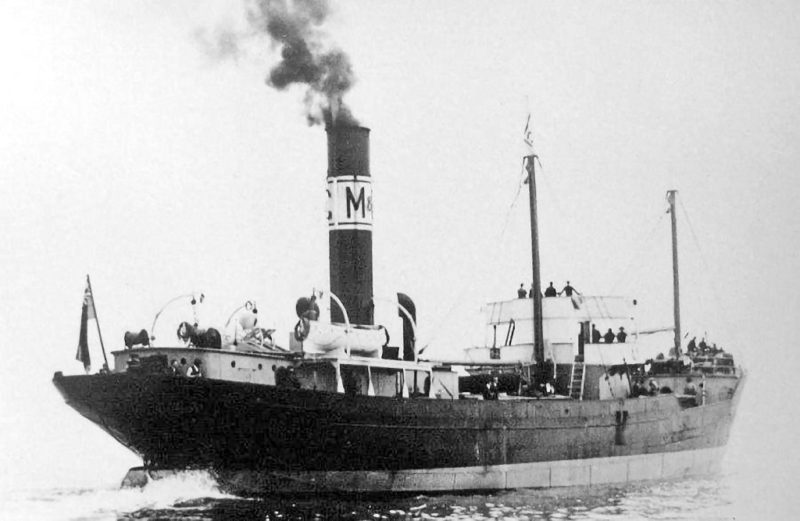
With a view to servicing those smaller ports of the region and their needs for coal in smaller consignments, the 1906 Ayr built 383 grt Grovehill was acquired during 1932 from James F. Brier of Bangor, County Down, duly renamed Naviedale and her Port of Registry transferred from Belfast to Aberdeen. During April 1944 this vessel was requisitioned by the Military Cargo Branch of the MoWT for the carriage of ammunition from Tilbury, preparatory to the Normandy Landings and placed under the management for such duration of Bloomfields Ltd., (Coastal Shipping Dept.) of London. During the period 5th June through 29th August, she undertook a total of eleven channel crossings mainly from Littlehampton but also from the Solent and Newhaven supplying the beaches of Juno, Sword, Arromanches and Gold. After her departure from the latter on 30th July, a stowaway soldier surrendered to the crew. During her return in convoy from ‘Juno’ during 2nd August, her steering gear jammed, causing her to sheer to starboard and collide with Christian Salvesen’s 847 grt 1924 Helsingborg completed Fenja, sustaining significant damage to her own bow and starboard lifeboat, to necessitate repairs at Southampton from 6th to 16th August. Her last Normandy operation before MoWT release followed her final return to Littlehampton on 29th August to load for Caen. The vessel continued trading until 1956, by which time her registered ownership had been transferred to that of Mr. Charles B Simpson, hitherto and for some years, principal manager of G. Couper & Co. Ltd. During 14th May 1956 the now 50 years old ship arrived at Dublin for breaking by the Hammond Lane Foundry.
During 1932, a third ship joined the Couper fleet in the form of the 717 grt Lowestoft 1921 built Marjorie Mellonie, when acquired from Sam Robford & Co. Ltd. of Ipswich, then a part of William Cory & Son. Renamed Helmsdale, whilst retaining her Ipswich Port of Registry, her service with her new owners lasted barely seven years, for during 19th July 1939 whilst on a voyage from Greenhithe for Inverkeithing with cement, she grounded in dense fog on shallow reefs on the northeast side of Crumstone on the Farne Islands and was wrecked, her crew of 10 being rescued by the Holy Isle lifeboat.

A further steam coaster was added during 1934 when the 312 grt 1921 Yarmouth built Broswall was acquired from the Liverpool based Wallace Brothers Ltd. and whilst retaining the Port of Registry of Liverpool, was renamed Halladale. Her tenure was also short lived, when, in the threat of impending war, she was sold during 1939 to the South Wales Sand & Gravel Co. Ltd., Swansea for conversion to a sand pump dredger.
1935 saw the purchase of the 160 grt 1905 Paisley built Swallow from the Wm. Muller & Co. (London) Ltd. subsidiary, the Vianda Steamship Company Ltd., when renamed Rimsdale, with Port of Registry retained at London and to be managed by Charles B. Simpson at Helmsdale. Temporarily renamed Rustoer pending sale, the vessel was disposed of during 1937 to the Island Steamship Co. Ltd., Glasgow under the management of George G. Jackson and renamed Isle Ornsay, with Port of Registry transferred to Glasgow.
The 345 grt Brockley Combe, completed as Redesmere at the Beverley Yard, Hull of Cook, Welton and Gemmell on 15th September 1921, was purchased from the Ald Shipping Co. Ltd. of Bristol during 1937 and renamed Lothdale whilst retaining the Port of Registry of Bristol. She appears to have had an event free career until 1953, when the vessel was sold to Bremner & Co. Ltd. (J.R. Bremner, Manager, Stromness) renamed Orkney Dawn and registered at Kirkwall.
During 1940 the 394 grt steamer Glen-Mary, completed during August 1921 by Crabtree & Co. Ltd., Great Yarmouth, was acquired by the Company during 1940 from F.T. Everard & Sons Ltd. of Greenhithe, London and in accordance with wartime regulations, without change of name or Port of Registry. The vessel was sold out of the fleet during 1947 to J. & A. Gardner & Co. Ltd. when registered at Glasgow as Saint Kearan.
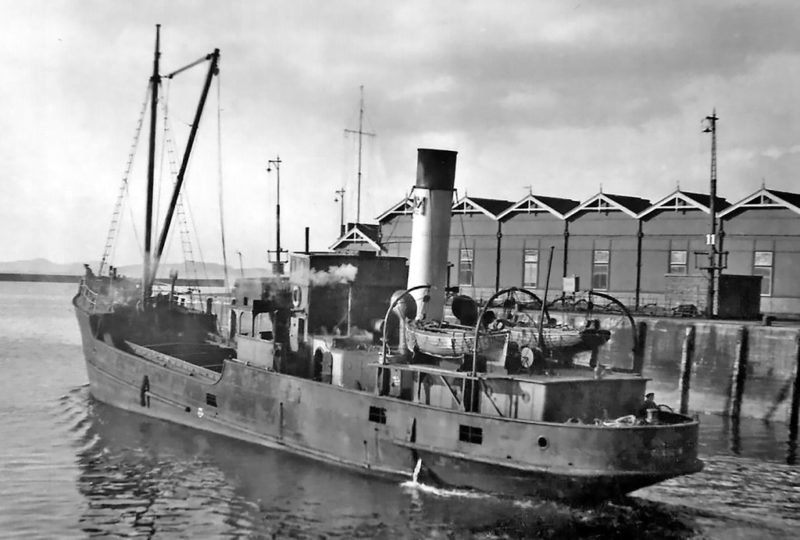
At the aftermath of WWII, it was becoming evident that the core business of George Couper & Co., that of particularly steam coal, was in decline due to falling numbers of steam drifters and trawlers and progressive replacement by oil engined vessels. At such time, the Company was being managed at Helmsdale by Mr. Charles B. Simpson and the decision made to retain the two surviving units of its fleet, Naviedale and Lothdale, with a view to reconstituting the shipping operation in the form of a new Company.

The process began during 1948 when the registered ownership of the pair was transferred to Mr. C.B. Simpson. The following year, the George Couper Company ceased trading and was replaced by the management company Northern Shipping & Trading Co. (Helmsdale) Ltd., of Aberdeen, led by C.B. Simpson and his fellow directors, sons Ian and George. Routine shipments continued in the carriage of a range of cargoes including coal from Methil and Blyth to Aberdeen, Moray Firth Ports, Wick, Kirkwall, Stromness and Lerwick with mainly summer voyages to Shetland with timber and return cargoes of drying seaweed from both Shetland and Orkney for processing at Lochboisdale, South Uist, or to Kirkwall with Fife grown malting barley loaded at Kirkcaldy for the Highland Park Distillery, returning with whisky in casks to Aberdeen.
Following disposal of Lothdale during 1953, as referenced earlier, it now remained for the Company to consider a prospective replacement for their remaining vessel, the then 47 year old Naviedale, in the form of a significantly more fuel efficient motorship. Thus during late 1954 a contract was signed with the West German shipbuilder Josef L. Meyer of Papenburg leading to the launch on 10th March 1956 of Helmsdale (II), the Company’s first and in the event, only newbuild. Completed during May 1956, the 402 grt/480 dwt vessel achieved a maximum trials speed of 10 knots for an in-service speed of 8 knots from her Koln constructed 6 cylinder 500 bhp Klockner-Humboldt-Deutz engine. She departed Aberdeen on her maiden voyage on 17th May 1956 just three days after her predecessor Naviedale had arrived at Dublin for demolition.
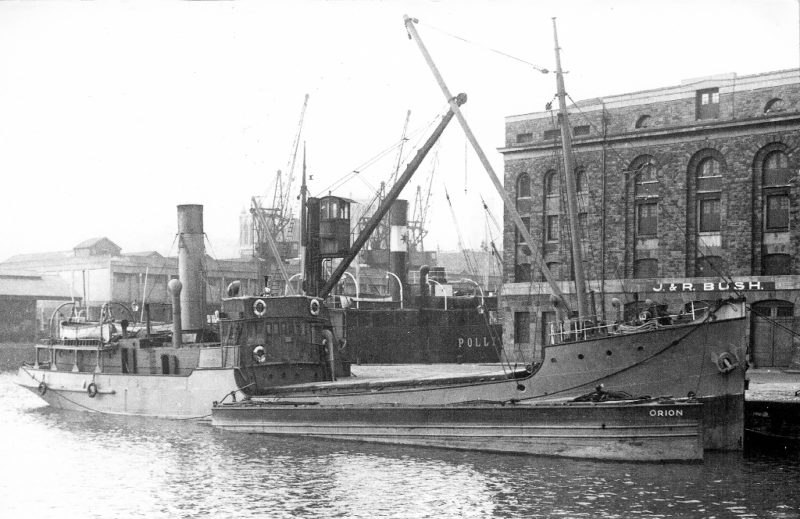
With much improved economics than earlier fleet units, Helmsdale ranged to ports far and wide in addition to her more locally based services, led by coal distribution from Methil, Blyth and Goole to Aberdeen, Peterhead, Wick and Kirkwall with return cargoes of seaweed for example from Orkney & Shetland during her continuing annual three summer weeks service to Alginate Industries, South Uist. Lucrative cargoes continued, including malting barley bulk loaded at Kirkcaldy for Kirkwall, returning with the casked product to Aberdeen. The latter shipments ceased however during early 1975, with the introduction of The North Company’s first Ro-Ro vessel, the then newly Aberdeen completed St Ola (III) on the Scrabster-Stromness ferry crossing, when road tankers carried the 100% proof liquid to Scottish mainland blenders. Occasional two day voyages to Hamburg to load ‘second fishery’ curing salt for whitefish and herring processing, were also undertaken to be landed at Aberdeen or Peterhead, as an alternative when necessary to Liverpool supplies.
Helmsdale’s surveys and annual drydockings were routinely undertaken at South Shields.

By the early 1960s significant diminution of the traditional coastal bulk trades, particularly in demand for both domestic, steam and bunker coal was clearly evident, driven by a combination of the increase in use of oil and gas for most energy needs and the Government’s requisite scrappage of all coal burning fishing vessels by 1963. Whilst other competing Aberdeen based collier operators were progressively replacing their steamers with motorships, sustainable mainly due to continuing rural demand for household coal and other bulk commodities. Such policy on a one-for-one basis was in the main being thwarted by the late 1960s introduction of fast and highly efficient rail services utilising purpose built coal-carrying rolling stock. It was clear therefore that the operation restricted to no more than a single ship on the part of the Northern Shipping & Trading Co. (Helmsdale) Ltd., was wholly justified. During 7th November 1980, whilst inbound to Montrose at the end of a voyage from Blyth with coal, Helmsdale stranded on rocks at Scurdie Ness Lighthouse at the southern entrance to the port. The vessel was abandoned and offered for sale ‘as is where is’. Later salvaged, she was found to be beyond economic repair and during early 1981 towed to Inverkeithing for breaking by Thomas W Ward & Co. Ltd.

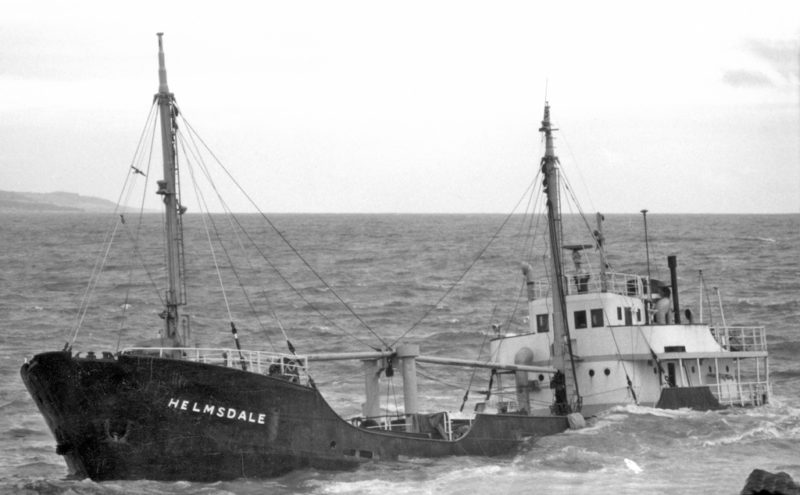
The Simpson family was quick to secure a replacement vessel in the form of J. & A. Gardner’s 433 grt Saint Ronan, completed on 11th March 1966 by Scott & Sons (Bowling) Ltd. at Bowling. Registered to the ownership of John Couper Simpson and Ann Mackay Simpson at Aberdeen, following her handover at Plantation Quay, Glasgow on 18th December 1980, she was renamed Helmsdale (III). Her first voyage as such was undertaken during late December from Blyth to Kirkwall with a coal cargo. During her Gardner years, the vessel appears to have been dogged by failures of her bridge controlled 12 cylinder 650 bhp four stroke single acting ‘Vee’ configured DR. reverse gear equipped engine, constructed by Dorman & Co. Ltd. of Stafford to achieve a service speed of 8 knots. This resulted in direct replacement of improved versions of this machinery on two occasions, during 1968 and 1973. It was unfortunate that by the time of this vessel’s entry into service under the Simpsons’ Northern Shipping & Trading Company (Helmsdale) Ltd., importation of Polish coal through Peterhead, Macduff and Inverness was underway, effectively and forever denying her of coal shipments into her home port. The lengthy miners’ strike of 1984-85 exacerbated and indeed accelerated the decline in supplies of UK sourced coal including smokeless fuels, resulting in increasing foreign imports, usually in the form of large tonnages single shipped to ports in the south and onwards transported by truck or rail, deeply affecting the ongoing operations of Helmsdale, by then the last remaining coaster registered at Aberdeen. She did however deliver her first post-strike shipment of 480 tons of household coal from Blyth to Peterhead on 13th March 1985. Later in the year however Helmsdale was forced into layup when she arrived at Buckie on 30th August 1985 where she lay until early 1987 when sold to a partnership of Neil Smith, John Rigby, Peter Ham, Avi Rosenberg and Peter Howerd of Basingstoke, with CKC Shipping Services, Managing Agents. The vessel was recorded as having arrived at Wick from Sunderland with a limestone cargo on 24th April 1987, under the unregistered name of Holly R, the only occasion during which she used the name. On 10th September 1987 she arrived at Leith to lay up pending her sale later in the month to Equaltrade Imports Ltd. of London, with Mardyke Shipping & Chartering Ltd, Hull appointed managing agents. During February 1990 she was sold to Andover Marine Services Ltd. of Norwich for demolition, arriving at Blyth as Helmsdale, under tow of the 229 grt tug Mister Cornishman (ex Hazelgarth, built Appledore, 1959) for dismantling by Oceanics UK Ltd. on Andover Marine’s behalf.
Thus ended the management operations of the Northern Shipping & Trading Company (Helmsdale) Ltd.
The photograph of the vessel referenced in paragraph four, captioned “The last coal cargo arrived at the harbour in 1984”, would clearly not have been of that of Helmsdale (II) of 1956-80. Rather, the likelihood is that the vessel to make that final delivery was Helmsdale (III) of 1980-85.
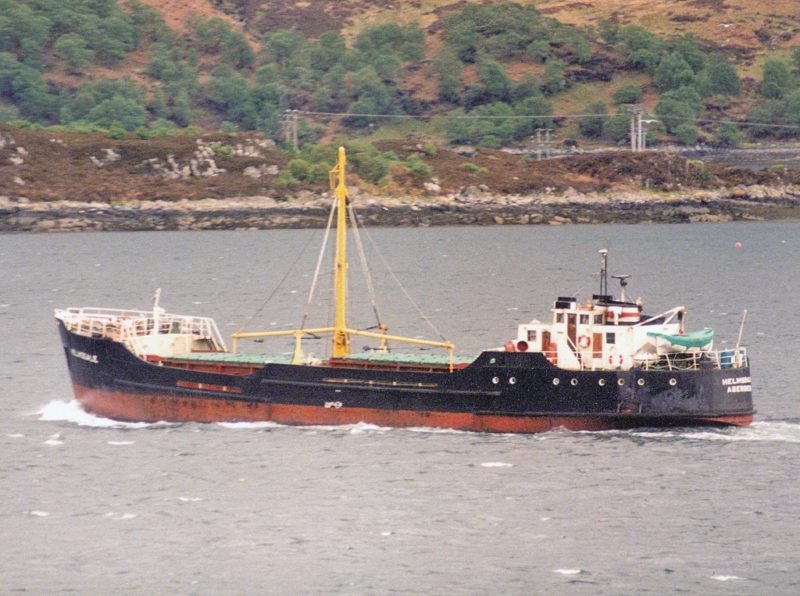
Bibliography:
Coastwise Sail, by John Anderson
The Aberdeen Colliers, by Peter Myers
J & A Gardner & Co. Ltd., Shipowners & Quarrymasters, by Graham Atkinson
Everard of Greenhithe, by K.S.Garrett
The Comprehensive Guide to Shipwrecks of the North East Coast, Vol.2 (1918-2000), by Ron Young.
Hay & Company, Merchants in Shetland, by James R. Nicolson, 1982.
Coasters go to War, Military Sailings to the Continent, 1939 -1945, by John de S. Winser
The North Boats, The story of the North of Scotland, Orkney & Shetland Shipping Company, by Alastair W. McRobb, 1999.
Shipwrecks of the North of Scotland, by R.N. Baird

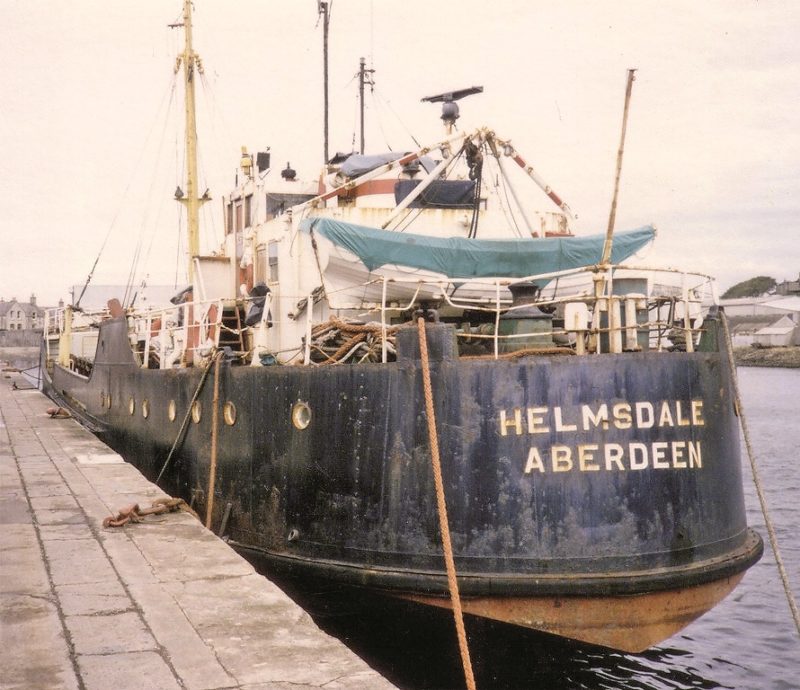
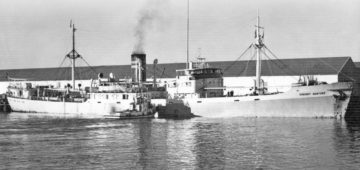



Comments
Sorry, comments are closed for this item